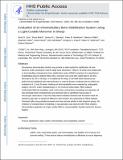| dc.contributor.author | Zani, Brett G. | |
| dc.contributor.author | Baird, Rose | |
| dc.contributor.author | Stanley, James R. L. | |
| dc.contributor.author | Markham, Peter M. | |
| dc.contributor.author | Wilke, Markus | |
| dc.contributor.author | Zeiter, Stephan | |
| dc.contributor.author | Beck, Aswin | |
| dc.contributor.author | Nehrbass, Dirk | |
| dc.contributor.author | Kopia, Gregory A. | |
| dc.contributor.author | Rabiner, Robert | |
| dc.contributor.author | Edelman, Elazer R | |
| dc.date.accessioned | 2016-06-01T18:15:06Z | |
| dc.date.available | 2016-06-01T18:15:06Z | |
| dc.date.issued | 2016-02 | |
| dc.date.submitted | 2014-08 | |
| dc.identifier.issn | 15524973 | |
| dc.identifier.issn | 1552-4981 | |
| dc.identifier.uri | http://hdl.handle.net/1721.1/102787 | |
| dc.description.abstract | Percutaneous intramedullary fixation may provide an ideal method for stabilization of bone fractures, while avoiding the need for large tissue dissections. Tibiae in 18 sheep were treated with an intramedullary photodynamic bone stabilization system (PBSS) that comprised a polyethylene terephthalate (Dacron) balloon filled with a monomer, cured with visible light in situ, and then harvested at 30, 90, or 180 days. In additional 40 sheep, a midshaft tibial osteotomy was performed and stabilized with external fixators or external fixators combined with the PBSS and evaluated at 8, 12, and 26 weeks. Healing and biocompatibility were evaluated by radiographic analysis, micro-computed tomography, and histopathology. In nonfractured sheep tibiae, PBSS implants conformably filled the medullary canal, while active cortical bone remodeling and apposition of new periosteal and/or endosteal bone was observed with no significant macroscopic or microscopic observations. Fractured sheep tibiae exhibited increased bone formation inside the osteotomy gap, with no significant difference when fixation was augmented by PBSS implants. Periosteal callus size gradually decreased over time and was similar in both treatment groups. No inhibition of endosteal bone remodeling or vascularization was observed with PBSS implants. Intramedullary application of a light-curable PBSS is a biocompatible, feasible method for fracture fixation | en_US |
| dc.description.sponsorship | National Institutes of Health (U.S.) (NIH grant R01 GM-49039) | en_US |
| dc.language.iso | en_US | |
| dc.publisher | Wiley Blackwell | en_US |
| dc.relation.isversionof | http://dx.doi.org/10.1002/jbm.b.33380 | en_US |
| dc.rights | Creative Commons Attribution-Noncommercial-Share Alike | en_US |
| dc.rights.uri | http://creativecommons.org/licenses/by-nc-sa/4.0/ | en_US |
| dc.source | PMC | en_US |
| dc.title | Evaluation of an intramedullary bone stabilization system using a light-curable monomer in sheep | en_US |
| dc.type | Article | en_US |
| dc.identifier.citation | Zani, Brett G., Rose Baird, James R. L. Stanley, Peter M. Markham, Markus Wilke, Stephan Zeiter, Aswin Beck, et al. “Evaluation of an Intramedullary Bone Stabilization System Using a Light-Curable Monomer in Sheep.” J. Biomed. Mater. Res. 104, no. 2 (March 12, 2015): 291–299. | en_US |
| dc.contributor.department | Massachusetts Institute of Technology. Institute for Medical Engineering & Science | en_US |
| dc.contributor.department | Harvard University--MIT Division of Health Sciences and Technology | en_US |
| dc.contributor.mitauthor | Edelman, Elazer R. | en_US |
| dc.relation.journal | Journal of Biomedical Materials Research Part B: Applied Biomaterials | en_US |
| dc.eprint.version | Author's final manuscript | en_US |
| dc.type.uri | http://purl.org/eprint/type/JournalArticle | en_US |
| eprint.status | http://purl.org/eprint/status/PeerReviewed | en_US |
| dspace.orderedauthors | Zani, Brett G.; Baird, Rose; Stanley, James R. L.; Markham, Peter M.; Wilke, Markus; Zeiter, Stephan; Beck, Aswin; Nehrbass, Dirk; Kopia, Gregory A.; Edelman, Elazer R.; Rabiner, Robert | en_US |
| dspace.embargo.terms | N | en_US |
| dc.identifier.orcid | https://orcid.org/0000-0002-7832-7156 | |
| mit.license | OPEN_ACCESS_POLICY | en_US |
| mit.metadata.status | Complete | |
